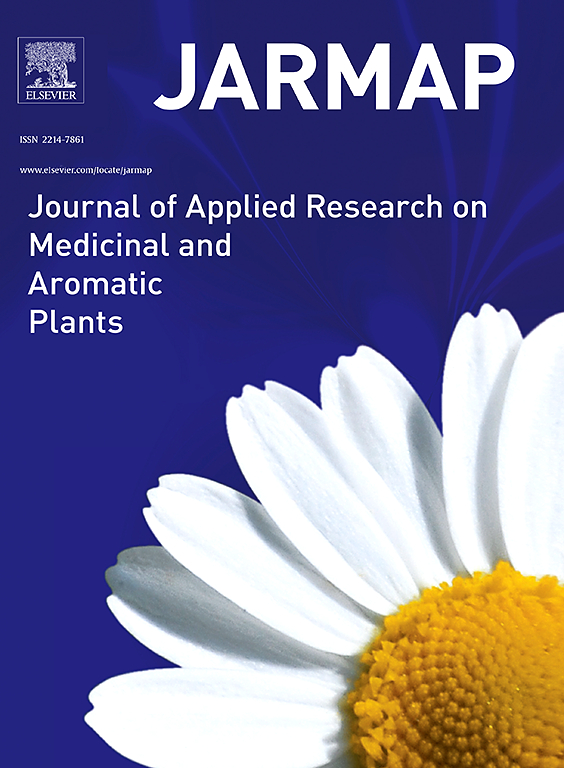印度匙羹藤种群遗传学综合分析及物种分布模型
IF 3.6
2区 农林科学
Q1 PLANT SCIENCES
Journal of Applied Research on Medicinal and Aromatic Plants
Pub Date : 2025-02-28
DOI:10.1016/j.jarmap.2025.100631
引用次数: 0
摘要
西尔维斯特(西班牙语)r . Br。Schult交货。是一种有效的抗糖尿病植物,产于非洲到澳大利亚的热带植物。几个世纪以来,它一直被用于土著和现代医学系统中,用于治疗糖尿病、蛇咬伤、疟疾、黄疸、哮喘、支气管炎、心脏病、白癜风、眼疾、肥胖等。在印度,该物种受到不可持续的制药业采伐和栖息地破坏的严重威胁。此外,持续的气候变化可能会影响其分布范围。因此,本研究的目的是在当前(1970-2000年)和预测的未来气候条件(2050年和2070年,代表性浓度路径4.5和RCP8.5)下,评估西尔华的遗传健康(遗传多样性和种群遗传结构)和潜在地理范围,以制定有效的保护、管理和可持续利用方法。遗传多样性{Observed杂合度(Ho = 0.391)、Nei’s Expected杂合度(He = 0.382)和Shannon’s information index (I = 0.656)}为中等水平,大部分遗传变异在群体内积累(74 %),群体间基因流(Nm = 0.637)中等,群体间Nei’s遗传分化非常高(FST = 0.281)。各种遗传聚类方法在118 G中产生了两个不同的(K = 2)遗传聚类。与地理隔离程度相称的个体数量。与目前相比,所有的未来预测都是悲观的,高适宜区和中等适宜区都有所减少。然而,与2050年相比,2070年适宜面积增加,有利于物种适应气候变化。本文章由计算机程序翻译,如有差异,请以英文原文为准。
An integrative analysis of population genetics and species distribution modeling of Gymnema sylvestre in India
Gymnema sylvestre (Retz.) R. Br. ex Schult., is a potent anti-diabetic, tropical plant species from Africa to Australia. It has been used since centuries both in indigenous and modern medicine systems to treat diabetes, snake bite, malaria, jaundice, asthma, bronchitis, cardiopathy, leukoderma, eye problems, obesity, etc. In India, the species is significantly threatened by unsustainable harvesting practices for pharmaceutical industries and habitat destruction. Moreover, the continuing climate change may affect its distributional range. Hence, the objective of this study was to evaluate the genetic health (genetic diversity and population genetic structure) and potential geographical range of G. sylvestre under both current (1970–2000) and projected future climatic conditions (2050 and 2070 under Representative Concentration Pathway 4.5 and RCP8.5) to develop effective conservation, management, and sustainable utilization approaches. A moderate level of genetic diversity was found {Observed Heterozygosity (Ho = 0.391), Nei’s Expected Heterozygosity (He = 0.382), and Shannon’s information index (I = 0.656)}, with majority of the genetic variation accumulated within populations (74 %), and very high Nei’s genetic differentiation among populations (FST = 0.281) was noticed as the Gene flow among populations (Nm = 0.637) was medium. Various genetic clustering methods yielded two distinct (K = 2) genetic clusters in 118 G. sylvestre individuals proportionate to the geographical isolation. Compared to the present, all the future projections came pessimistically with a reduction in the high and moderate suitable areas. However, 2070 would favor the species in adaptation to the changed climate with increased suitable area compared to the year 2050.
求助全文
通过发布文献求助,成功后即可免费获取论文全文。
去求助
来源期刊

Journal of Applied Research on Medicinal and Aromatic Plants
Pharmacology, Toxicology and Pharmaceutics-Drug Discovery
CiteScore
6.40
自引率
7.70%
发文量
80
审稿时长
41 days
期刊介绍:
JARMAP is a peer reviewed and multidisciplinary communication platform, covering all aspects of the raw material supply chain of medicinal and aromatic plants. JARMAP aims to improve production of tailor made commodities by addressing the various requirements of manufacturers of herbal medicines, herbal teas, seasoning herbs, food and feed supplements and cosmetics. JARMAP covers research on genetic resources, breeding, wild-collection, domestication, propagation, cultivation, phytopathology and plant protection, mechanization, conservation, processing, quality assurance, analytics and economics. JARMAP publishes reviews, original research articles and short communications related to research.
 求助内容:
求助内容: 应助结果提醒方式:
应助结果提醒方式:


